This Holiday Brisket is one of my more popular brisket recipes for the Jewish holidays. It is inspired by a classic Ashkenazi sweet-and-sour brisket, but the flavors here are more subtle. This brisket is savory, aromatic, and subtly sweet with just a touch of tang. It’s always a crowd pleaser!
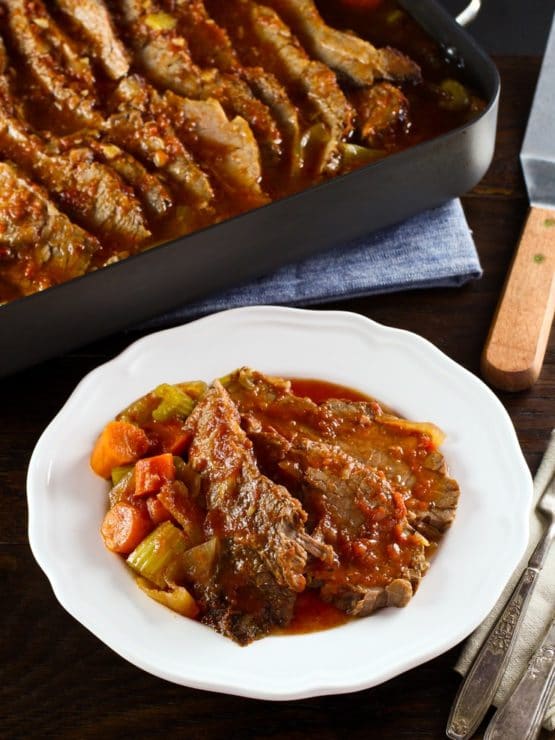
Jews living in Eastern Europe rarely had the money to buy better cuts of meat. They learned to make do with cheaper kosher cuts, like brisket, oft overlooked for its toughness. Cooking the brisket low and slow breaks it down, resulting in a tender piece of meat.
This Jewish tradition continues today, and brisket is often served for special holidays and occasions. On Shabbat, it is added to a pot with vegetables and potatoes to make a slow-cooked meaty stew known as cholent. At Rosh Hashanah, it is added to root vegetables with sweet dried fruits and slow cooked into tzimmes.
When Ashkenazi Jewish immigrants came to the United States, they brought their love of brisket with them. Jewish deli owners pickled the brisket to make corned beef or pastrami. But for the holidays, nothing could replace the comforting, hearty flavor of an oven-roasted brisket.
How to make brisket tender
The secret to a cooking brisket is twofold– brisket fat and time are key for tender and delicious results. Choose a cut with nice marbling; the more fat you can see, the more tender the meat will be. If buying grass fed (which tends to be leaner), make sure there is a fat layer and don’t let the butcher trim it. And of course, allow yourself plenty of time to cook your brisket. If you can, make it a day or two ahead– the flavor will improve with time. More tips here: How to Cook Brisket – Tips and Recipes
My Holiday Brisket slow cooks for hours, so the final product flakes tenderly and simply melts in your mouth. The sauce is rich and flavorful, and the slow cooked vegetables are soft, like butter. The flavor is perfect for any special celebration, but particularly suited to the Jewish holidays. Enjoy!
What is traditionally served with Brisket?
Olive Oil Mashed Potatoes with Garlic and Rosemary
Roasted Rosemary Balsamic Tzimmes
Butternut Squash and Crispy Kale Bake
Green Beans with Balsamic Date Reduction Feta and Pine Nuts
Kale and Roasted Beet Salad with Maple Balsamic Dressing
Throwback Recording: In this radio interview with Joan Hamburg, we talked about this very brisket recipe, as well as Passover cooking. You can listen by clicking the triangle “play” button below.
Recommended Products:
We are a participant in the Amazon Services LLC Associates Program, an affiliate advertising program designed to provide a means for us to earn fees by linking to Amazon.com and affiliated sites. As an Amazon Associate I earn from qualifying purchases.
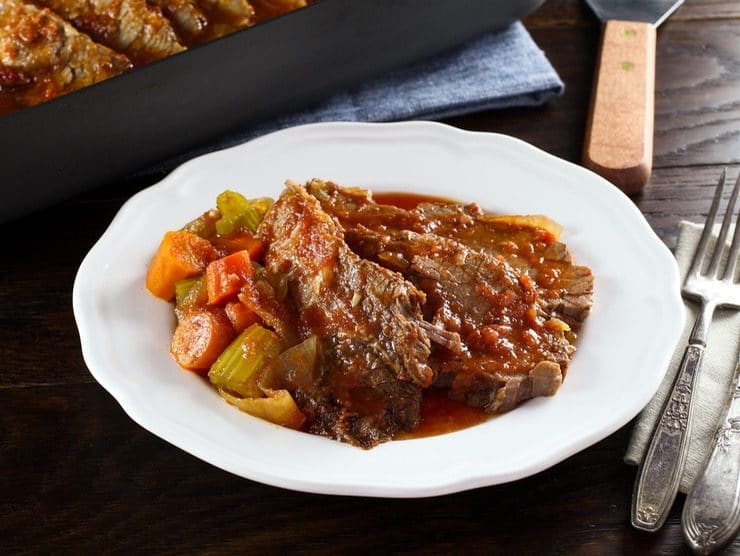
Food Photography and Styling by Kelly Jaggers
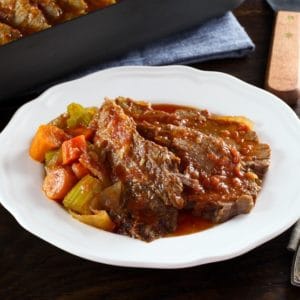
Holiday Brisket
Ingredients
- 5-7 pounds brisket, first or second cut (do not trim fat - especially if it's grass fed)
- 1/4 cup extra virgin olive oil, divided
- 2 large brown onions, peeled and sliced
- 1 pound carrots, peeled and sliced
- 1 pound celery, peeled and sliced
- 28 ounces tomatoes - whole, diced, or crushed (1 large can)
- 10 peeled whole garlic cloves
- 1/2 cup brown sugar
- 1/4 cup vinegar (I like apple cider vinegar, but white vinegar works too)
- 2 cups beef or chicken broth, divided
- Salt and pepper
NOTES
Instructions
- Preheat oven to 300 degrees F. Rinse the brisket and pat dry. Rub both sides of the meat with black pepper and salt. Heat a large skillet over a medium flame on the stovetop. Drizzle 2 tbsp of olive oil into the pan. Brown the brisket on both sides—it will take 4-5 minutes per side. A large brisket may overlap the edges of the skillet; you can brown it in stages, letting half the brisket overlap the edge, then adjusting it to brown the other half.

- While brisket is browning, pour canned tomatoes, garlic, brown sugar, apple cider vinegar, and 1 ½ cups broth into a blender or food processor. Add 2 tsp of salt (or 1 tsp if using a salted kosher cut of brisket) and ¼ tsp of black pepper. Pulse till garlic is chopped small and all ingredients are combined.

- Remove the browned brisket from the skillet.

- Drizzle 2 tbsp more olive oil in the pan and add the sliced onions. Saute them over medium high for a few minutes until they begin to soften and shrink in size.

- Add the carrot and celery slices. Sauté for another 5-6 minutes until the onions are soft and browning and the vegetables are fragrant.

- Pour the vegetables out of the skillet and onto a plate, reserve. Add 1/2 cup beef stock or chicken stock into the skillet and let it heat up. Use a spatula to gently scrape up any brown bits and pan juices that are clinging to the skillet. Turn off heat.

- Pour half of the tomato mixture into a large roasting pan.

- Place brisket on top of the tomato sauce, fat cap facing up.

- Pour the sauteed vegetables across the top of the brisket, along with the broth and brown bits.

- Pour the remaining tomato sauce over the top of the vegetables and brisket.

- Cover the roasting pan tightly with a layer of parchment paper followed by a layer of foil. The parchment forms a protective layer between the meat and sauce (which is acidic) and the foil.

- Place brisket in the oven. Let it roast undisturbed for 5 to 7 hours. It will take about 1 hour per pound of meat (leaner cuts of meat like grass fed may take longer—test for doneness). Brisket is ready when it flakes tenderly when pierced with a fork. You can let it cook even longer for a soft, shredded texture if that’s what you prefer. When fully cooked, the brisket will have shrunk in size.I recommend making this brisket ahead; allowing it to sit in the refrigerator for 1-2 nights will improve the flavor. If you would like to do this, skip ahead to where it says “Make Ahead Directions.” If you are not making ahead, continue reading.

- Remove brisket from the pan and let it rest on the cutting board fat-side up for 20-30 minutes. Meanwhile, pour the sauce and vegetables from the roasting pan into a smaller saucepan. Skim fat from the surface of the cooking sauce, then reheat the sauce till hot (not boiling).Cut fat cap off the brisket, then cut the brisket in thin slices against the grain. Serve topped with hot tomato sauce and softened veggies.

- Make Ahead Directions: Open the foil to vent and let the brisket slowly return to room temperature. Switch the brisket and sauce to a ceramic or glass dish (metal from the roasting pan can react with the acid in the sauce, which can cause an off taste if left to sit). Cover with plastic wrap and place in the refrigerator. Let the brisket chill overnight, or up to two days. You can also freeze the brisket if you prefer.

- 1-2 hours before serving, remove the brisket from the refrigerator and preheat your oven to 350 degrees F. The fat in the sauce will have risen to the top, turned white, and solidified. Use a spoon to scoop the fat bits out of the sauce and discard.

- Take the brisket out of the dish and brush any excess sauce back into the dish. Place brisket on a cutting board, fat-side up. Slice the meat cold—first cut the fat cap off the brisket, then cut the brisket in thin slices against the grain.

- Return the sliced meat to the dish and spoon sauce over it, making sure to spoon a little sauce between each slice. Cover the dish with a layer of parchment paper, then with foil, and place it in the oven.

- Let the brisket roast for 45-60 minutes until heated through. You can cook the brisket even longer to let it become more tender, if you wish. Serve with hot sauce and softened veggies. If you prefer, you can use a slow cooker to reheat. Set the slow cooker to high heat and cook until heated through, about 1 hour.

Nutrition

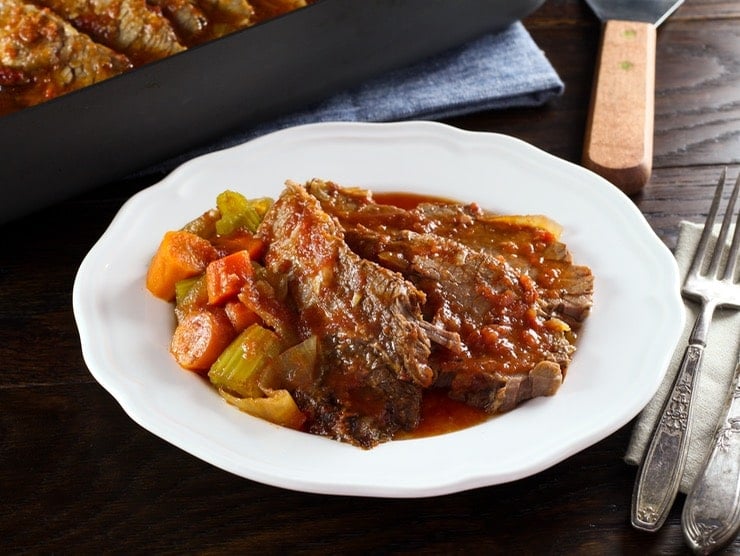
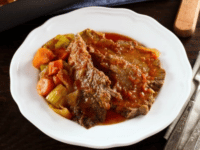
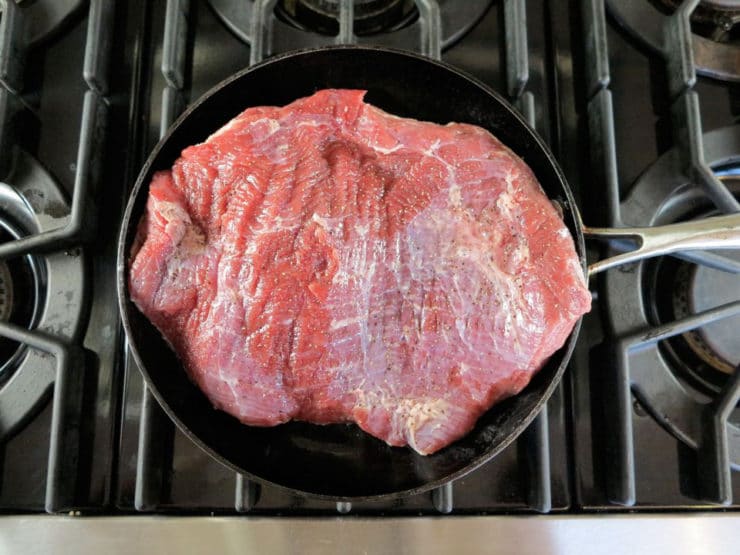
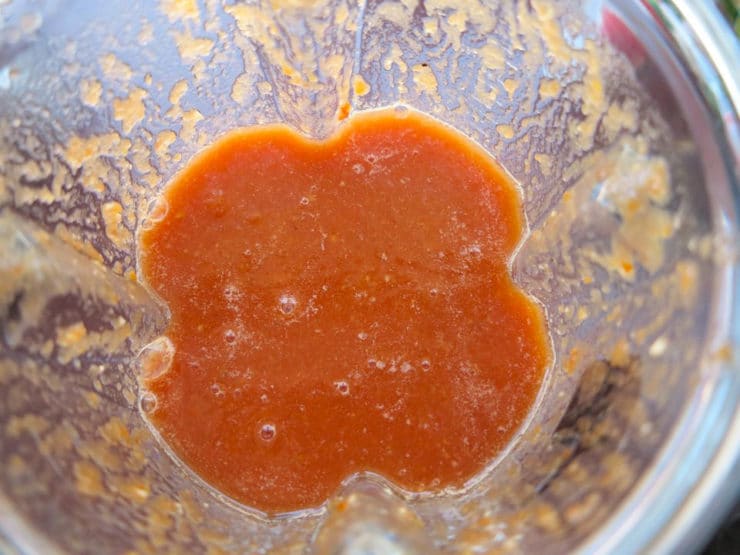
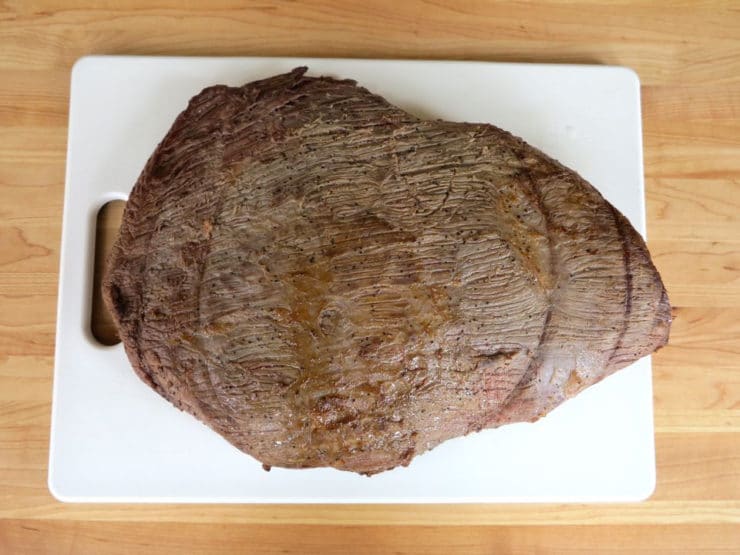


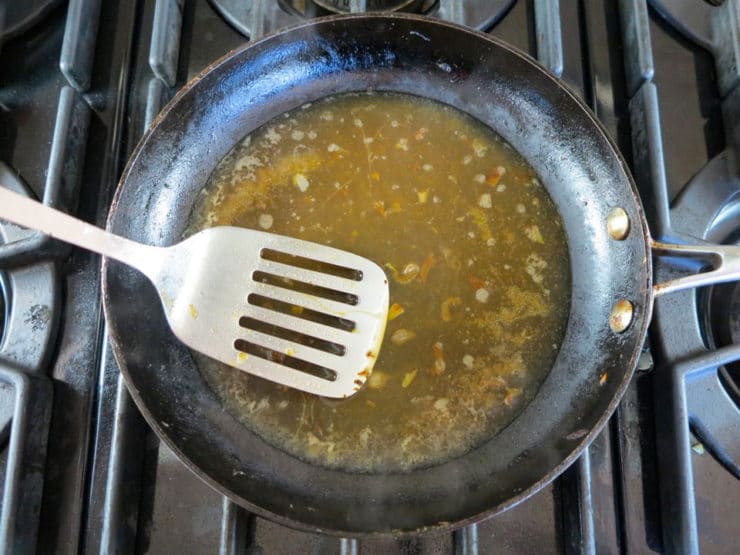
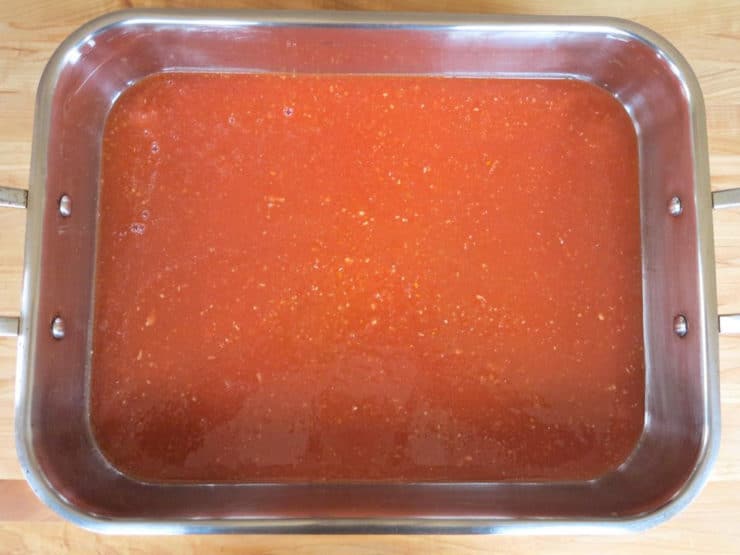
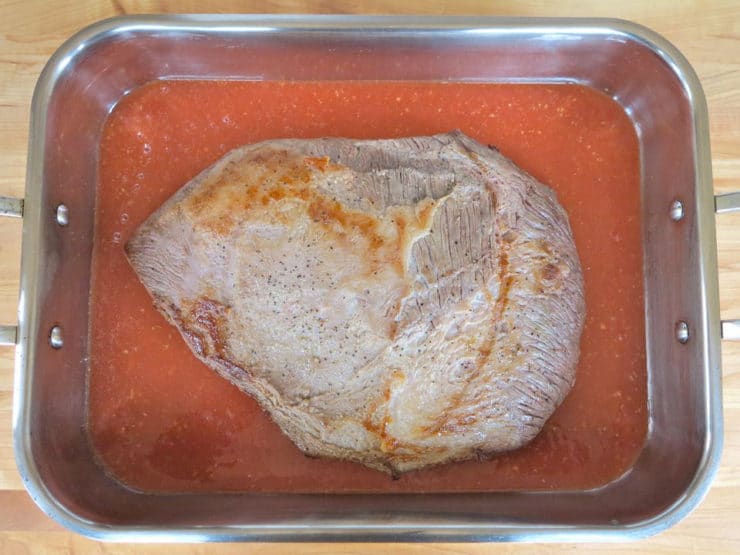
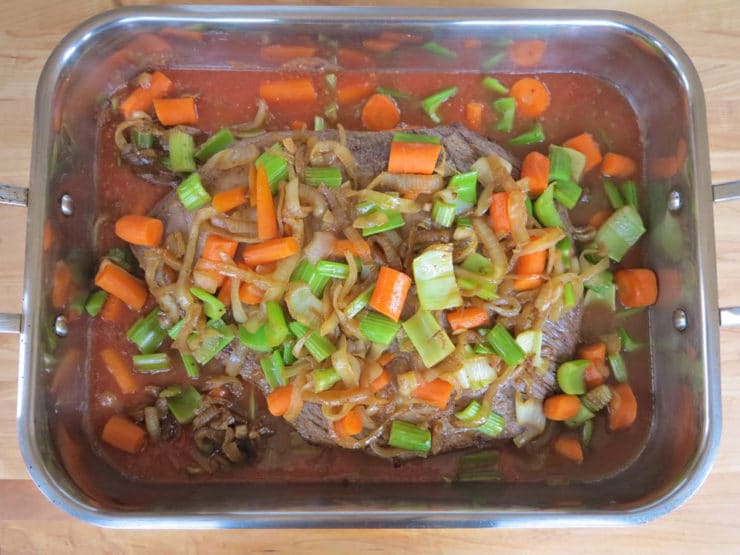
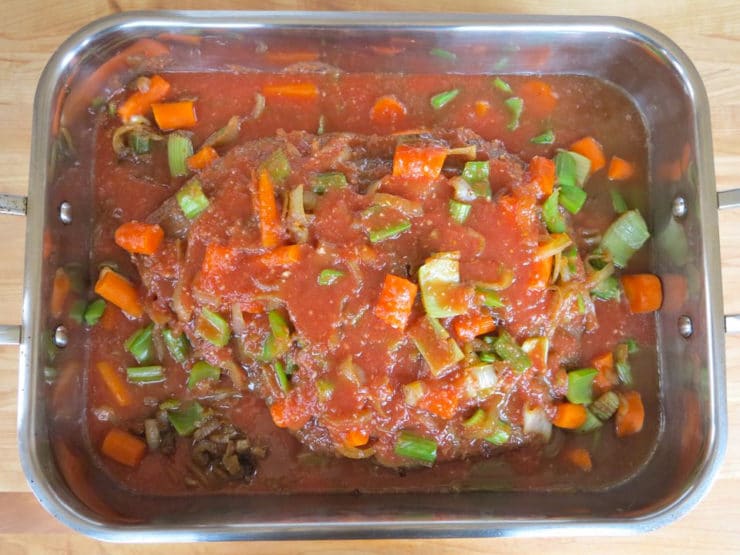

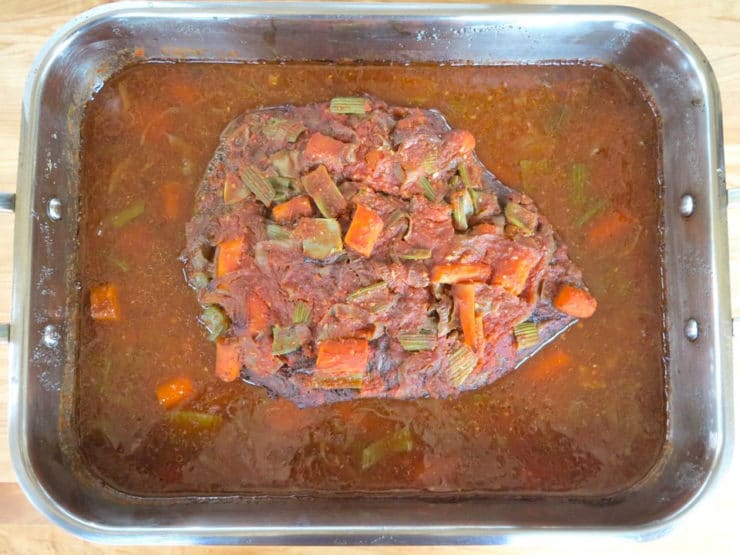
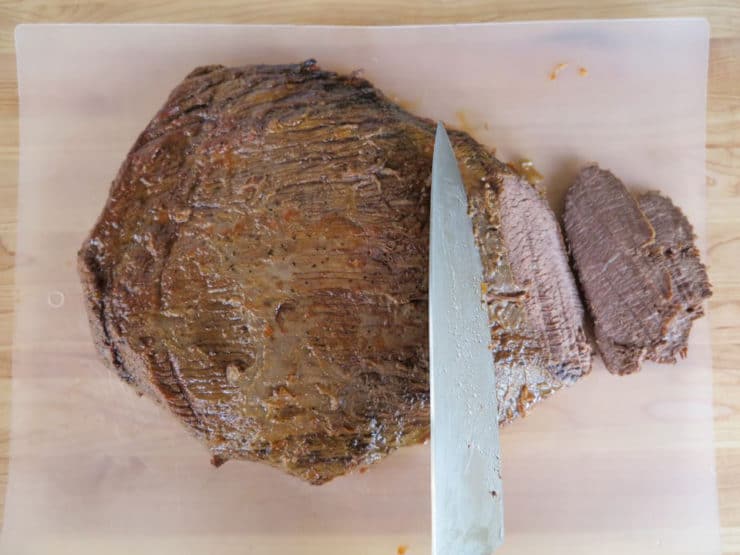
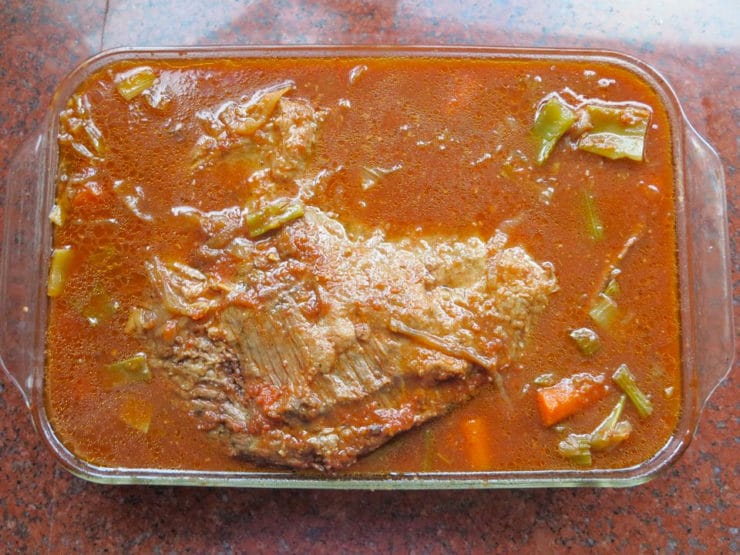
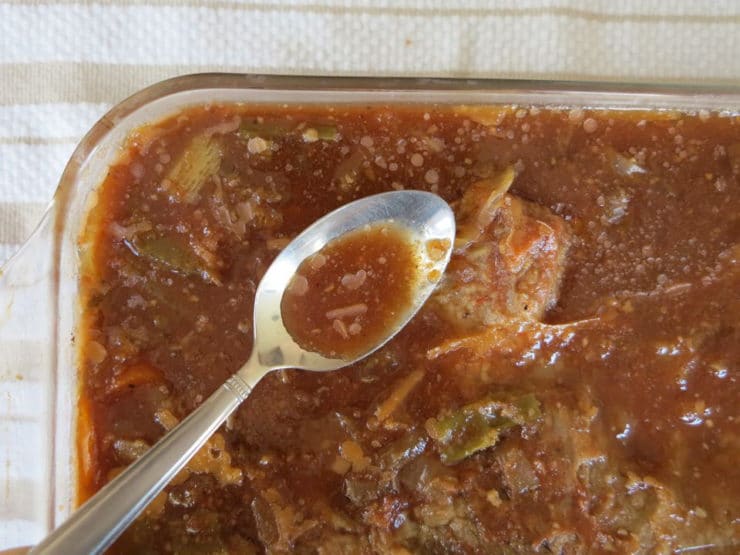
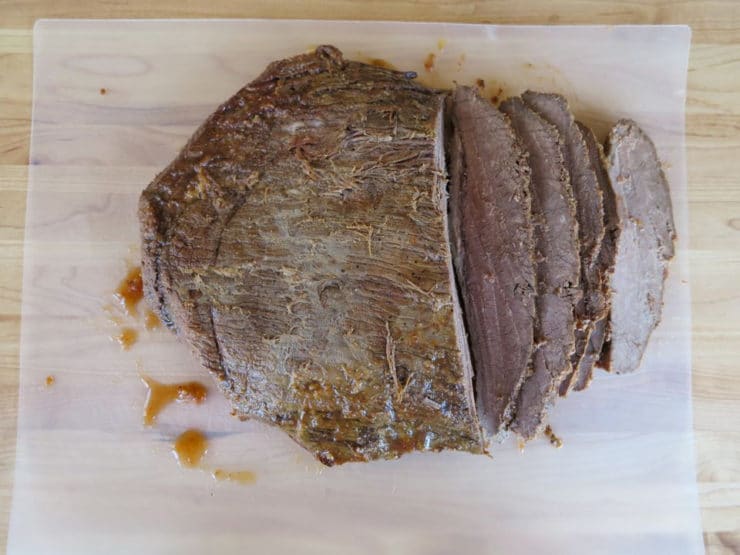
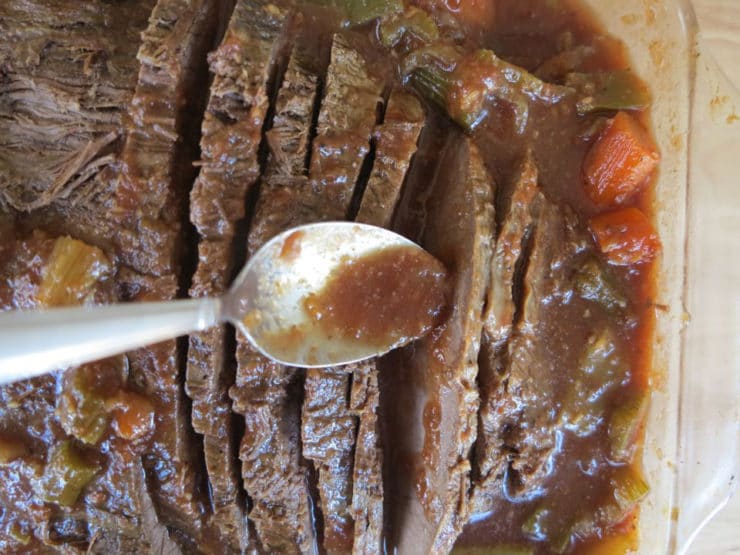
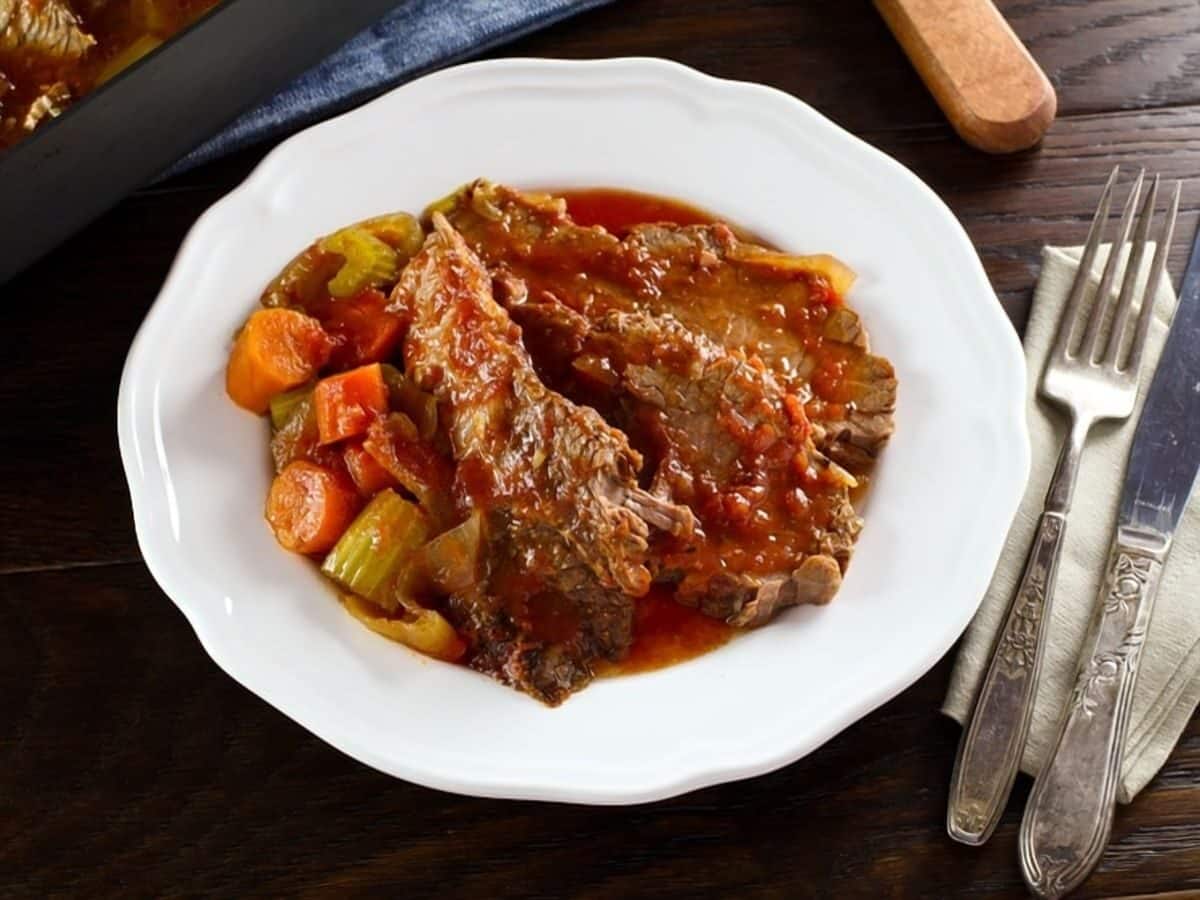


Hi Tori
When cooking two briskets of different weights, how should I time them for deliciousness? They are in the oven now.
Thank you.
Judith
Judala@adelphia.net
It’s a texture thing – check the smaller one first, and when it becomes fork tender/flaky it’s ready. Then start checking the second one.
Thank you so much for this recipe, it has made me a hero every Passover and Rosh Hashannah. I swear by it. One note in case it helps anyone: like a few other commenters, I had the sauce evaporate and the vegetables burn. That happened twice, and one of those times the bottom of the brisket also burned a little. Yet I had made it seamlessly before that.. I’m still not sure what happened, but I took a guess that maybe my roasting pan wasn’t deep enough. I bought a very deep foil pan and it cooked perfectly today. I don’t know if that was the problem, but FYI. Thanks again.
Thanks for the feedback JSH. I’ve never had this problem with this brisket (and we make it often for holidays), so I admit I was a bit perplexed by the comments. That seems like it might be the right conclusion. Also ovens tend to run hotter on the bottom, so cooking this on the middle rack would also help.
For the non-balabustas among us, the one thing I learned from this recipe is to prep (cut, slice, peel) all ingredients BEFORE starting the actual cooking. I was the proverbial one-handed paper hanger doing this recipe, but everything that doesn’t cause a fire in the kitchen makes me stronger! I can’t rate the recipe yet because it’s still in the oven. Plan to refrigerate.
Enjoy Dan! Yes prepping ahead makes things a LOT less stressful.
In cooking, do we aim for a certain meat temperature?
If cooked as written, you won’t need to worry about temperature – it will be very, very well cooked. Technically 195 degrees F is meat safe, for future reference – but this recipe is cooked long, low and slow to break down the meat fibers – so here you’re going more for a texture than a temp.
I’ve made several beef stews and other braises but none in this specific style. Between Howard Wolowitz and Midge Maisel I finally decided to give this a go. I loved it. The family loved it.
I did consult with a few Jewish friends for recommendations. All of them pleaded ignorance in favor of asking their mother-in-law. (haha). But one recommendation was to use beer in the braise, which I did, and I’ll do it again. Definitely recommend this recipe.
We love this brisket and I have made it 3 times already, however, something I am doing is causing the sauce to burn and we are left with very little sauce. I even turned the temperature down to 275 degrees. I am using exactly what the recipe calls for…any ideas what might be wrong? Thank you! I just want to get it right!!!
That is odd! What kind of pan are you using? You might try making this in the slow cooker if you continue having this issue, it definitely shouldn’t burn or be dry.
Tori may I also use a pyrex to place the brisket in the oven? If yes, should I use parchment paper? Thank you!
I’m not Tori, but I’ve been making this recipe in a large Pyrex for several years, multiple times a year. It works wonderfully and yes I still use the parchment paper!
Hi Tori! May I make this in a slow cooker instead? Would it taste any different? I am planning to make this on the same day with no ahead of time preparation. Thank you so much!
You can! Follow the basic instructions here: https://toriavey.com/toris-kitchen/savory-slow-cooker-brisket/ and simply modify it for the Holiday Brisket recipe.
Hi Tori!
I just made this and the brisket itself is amazing! Unfortunately I didnt realize, but I used too little of the sauce ingredients (I think!). I reduced the serving 🙁 and I think there wasn’t enough sauce.
Any tips on how to fix this issue without needing to start over???
Thank you so much!
You can make a small pot of the sauce separately – just add the sauce ingredients to a pot, then simmer until vegetables are tender and fragrant.
Love this recipe Tori! I made it in the slow cooker, blended up all the sauce and veggies at the end. We gobbled up the meat and now I’m left with 4-5 cups of the amazing sauce. Any ideas what to do with it? I saw another commenter say they are just dipping everything in it. Any other ideas out there?
Thanks!
Hi Helen! This may be a bit late, but it would work great as a chicken marinade, or over roasted vegetables. So glad you enjoyed the brisket!
Fantastic recipe. I usually smoke my briskets, but thought I would try something different this year. Came out so tender and juicy and flavorful. Has anyone tried to partially smoke the brisket before braising it to add a little smokiness to this recipe? I’m going to have to try that.
After 30 years of trying to master a brisket, this recipe finally worked. Everyone including me loves it. Its not difficult and its really as good as my aunts! Thank you
Amazingly delicious! Thank you so much for sharing your recipe. I cooked mine in a dutch oven from start to finish. The sauce was out-of-this-world! I had some leftover sauce and I didn’t want to throw it away—I was dunking everything in it! Thanks again!
I always double check a few tried and true recipes on the internet like yours before venturing on my own always unique Chanukah brisket journey. I do this to check my own concoction against some basic guidelines more than anything because I probably end up making it a little differently every year. For example, this year I threw in a ton of red wine and a quarter of a bottle of this sparkling non alcoholic sangria I had in the fridge lol. Also added thyme and rosemary for an herbaceous kick.
All of this to say: even though I don’t really strictly follow anyone’s recipe, the reason I come back to this particular recipe year after year is to remind myself on the basic elements of a showstopper brisket that never disappoints and this one clearly never does. If you brown your meat properly (I always get a very strong sear and do not trim fat on an already leaner cut of the brisket), brown your veggies, cover with enough of a sweet and savory braising broth and exercise patience and self control (trust the process and don’t peek in that oven – sometimes I let this go for up to 8 hrs like tonight!) you’re always gonna have an awesome brisket!
Thanks so much for the detailed instructions! I’d like to make this a day ahead of time. Do you see any issues with slicing the meat the day before and leaving it in the sauce overnight in the fridge (as opposed to cutting it on the day)?
Not at all, it will taste even better the second day. Just be sure to cover it with plastic or something similar (not aluminum foil – the acid will interact with it and give the sauce an off taste).
Amazing! First time making brisket and I will definitely use this recipe again! Had a smaller cut of meat so did one hour to a pound. Vegetables turned out delicious too! Thank you !
hi! looking forward to trying this today. QUESTION – can i use a dutch oven instead of the tin foil / pan technique?
Sure!
Any changes to amount of cooking time? Trying this tomorrow in Dutch Oven
Just wanted to drop a note while I’m currently cooking this for Channukah. I have been making this at least twice a year (channukah and Passover) since this blog was still called the Shiksa. It’s the best brisket out there!
Glad to hear it! Happy Hanukkah 🙂
Hi Tori – can I cook this without the parchment paper layer? Or is that absolutely necessary?
Thanks!
Yes you can. I just like to keep a separation between the foil and the food, but it’s not required.
Just made this exactly as written for Hanukkah tomorrow night and have a few thoughts. I LOVE all your details Tori. Your recipe was really well presented & clear. Everything went as planned and am putting it in the fridge overnight but am really disappointed in the flavor. All I can come up with is that there is a really strong, off garlic taste that hits the nose before even tasting it which is really unpleasant. I wish I had sauteed the garlic with the onions instead of blending it. I’ll see what I can do tomorrow to try to fix it. Maybe simmering the sauce? Not sure.
Sorry to hear that Suzanne! I’ve never had this complaint before. I hope it improves overnight and you end up enjoying it. If not, you might try my savory brisket, which might be more of the flavor profile you are looking for: https://toriavey.com/toris-kitchen/savory-herb-braised-brisket/
Hi Tori, I just made this and the liquid completely cooked out, the the vegetables in the pan all burned, and the meat is very dry. What did I do wrong? The foil was tight around the roasting pan, i used all the ingredients. Clearly I messed up somewhere and I’d love to know your thoughts.
Adam, so sorry to hear this! This must have to do with cook temperature. It sounds like your oven temp was too high. Have you calibrated your oven recently? Some ovens run hotter than others. Also did you use a very lean brisket cut, or perhaps grass fed? If the brisket is trimmed of all fat and doesn’t have enough fat between the fibers, it won’t become moist and tender with slow cooking.